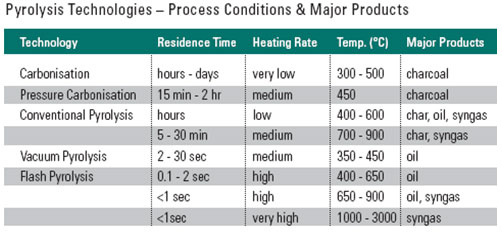-

What Is Pyrolysis?

Pyrolysis is the thermal degradation of waste in an oxygen-free environment, or in an environment in which the oxygen content is too low for combustion or gasification to take place. Pyrolysis liquefaction is a non-combustion heat treatment that chemically decomposes waste material by applying direct or indirect heat to the waste material in an oxygen-free environment.
Pyrolysis is an endothermic reaction (unlike gasification and combustion, which are usually exothermic reactions) and requires an input of energy that is typically applied indirectly, through the walls of the reactor in which the waste material is placed for treatment.

Pyrolysis typically occurs under pressure and at operating temperatures above 430 °C (800 °F). The process generally produces char, oil, and syn-gas, the ratios of each depending on the feedstock and the specific pyrolysis conditions (temperature, residence time, heating rate, pressure, and degree of mixing) that are used.
There are a number of different kinds of liquefaction processes, all of which differ significantly with respect to residence time (for the waste material), heating rate, temperature, and by-products. These range from carbonization, which can take up to 24 hours and produces coal at low temperatures, to flash pyrolysis, which takes less than a second and produces syn-gas at extremely high temperatures. A summary of the process conditions and by-products of the different pyrolysis processes is set out in the table below.

Klean Industries offers several types of pyrolysis liquefaction systems, including the rotary kiln, rotary hearth unit, and the fluidized bed; some systems provide direct heat, others indirect, and both continuous feed and batch feed variations are available. Both the pyrolysis and the gasification processes turn waste into energy-rich fuels by heating the waste under controlled conditions. As opposed to incineration, which fully converts the input waste into energy and ash, these processes are designed to limit the conversion process so that the products of the waste input can be controlled, such that the waste material is transformed into valuable by-products that can be directly reused in a variety of industries or processed further for more specific industrial applications.
We support our client’s through our quoting and project development by providing a wealth of information and specifications about Klean Industries systems and technologies.
©2024 All Rights Reserved. Terms of Use